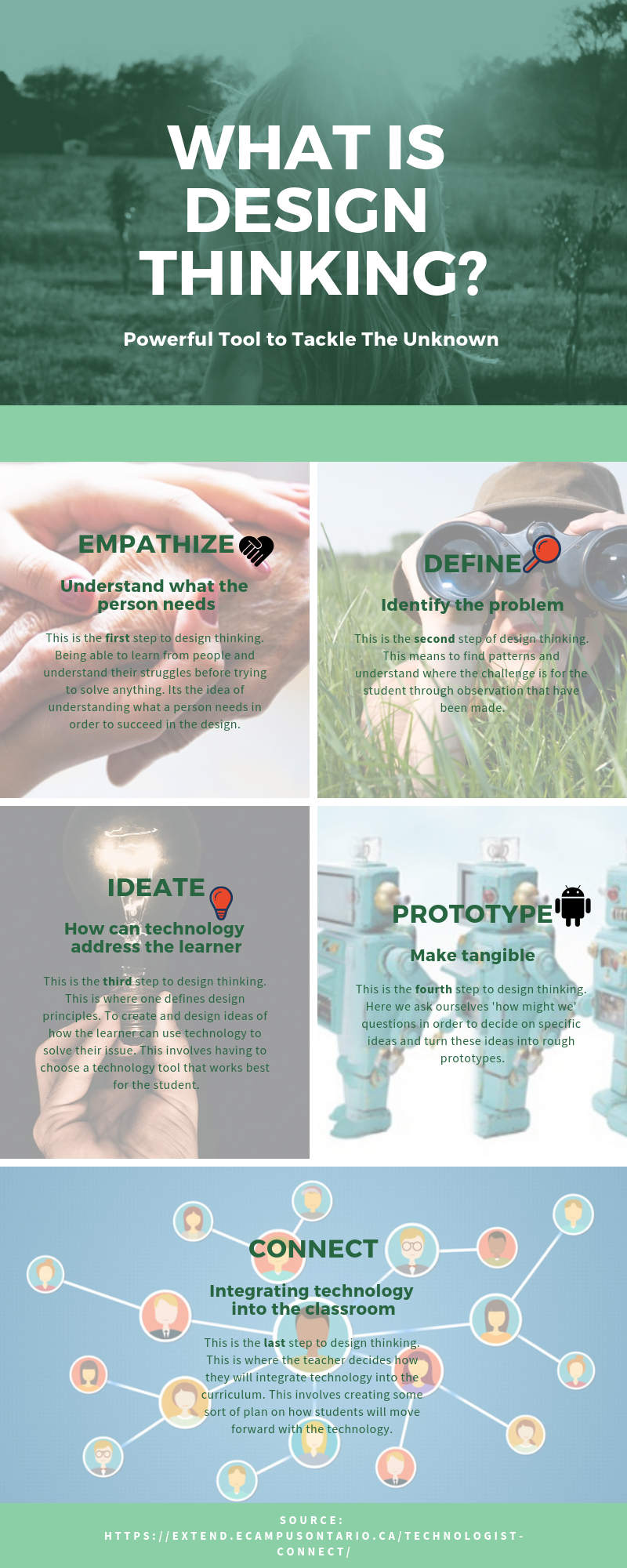For my form of media, chose to create an infographic on Canva; here it is if you would like to look at a larger version.
For our media form, we were responsible for reviewing the Technologist Module of eCapmus Ontario’s open PD modules which describes the different aspects of Design Thinking. This module summarizes the five main steps it takes in order to integrate technology with the use of design thinking. Design thinking is simply the strategic methods used to develop and create concepts. In my infographic I have set these five steps very clearly which a small bubble of information on each step and what it means. In the module, on the other hand, are a large variety of other sources and links offered for viewers reference in each step of this process. This includes Wikipedia links, YouTube videos and more.
I believe that these steps are very simple to understand, and in turn easy to follow as a teacher. I think that as teachers, we tend to follow through with some of these steps naturally such as trying to figure out where a student may be struggling, or trying to figure out how to help said student. I have experienced this personally in my practicum, where a student seemed to be disruptive in class; measures were taken to figure out why they couldn’t focus. My associate and I later discovered that the student had avoidance issues which in turn caused them to feel the need to avoid anything that makes them uncomfortable or that they do not understand. I do believe that with this specific set of steps any teacher should be able to move their students forward in a positive direction, whether it involves technology or not. When considering the integration of technology specifically I feel that it becomes more difficult as it is another concept being added. Being a teacher who is not fully aware of all the technology advances, there is a slight feeling of intimidation with the process. With that it, it becomes essential for teachers to take things step by step in order to not feel as overwhelmed.
As a science teacher, I very much appreciate the procedural approach that the module takes in solving a problem while also integrating technology. In my own experiences, the hardest part of getting through to a child is having them tell you that they are actually struggling. Many students are not comfortable enough to tell a teacher that they do not understand something. The only way this will happen is if the student trusts the teacher which is why I agree completely with having the first step be empathy. Once the student is able to open up, the teacher is then able to specifically define the struggles the student is having. I feel that this may be easy to do on paper, but is the hardest part in a real classroom as sometimes there are underlying issues which are the root cause of smaller issues that are easier to see. I have done student observations and anecdotals and in my opinion it becomes very hard to keep track of every student’s academic characteristics while also having multiple observations per student. In terms of having to ideate a design for the students, I think that it is essential for a teacher to have multiple sources to use. The module itself provides many external resources and link which provide extra information for the user which is very helpful. The more knowledgeable one is on an issue, the better they will be at solving it.

